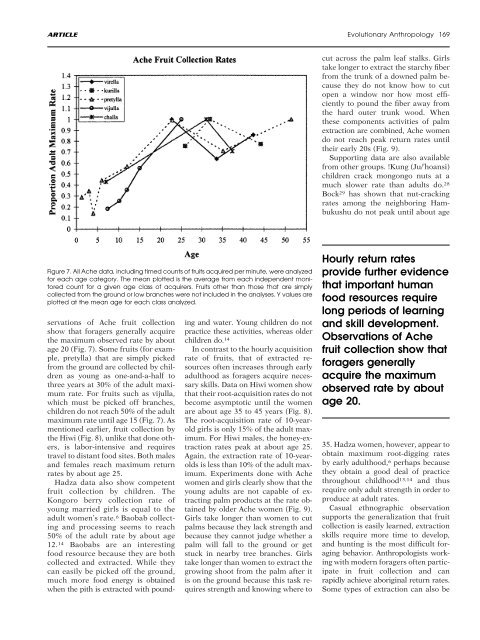A Theory of Human Life History Evolution - Radical Anthropology ...
A Theory of Human Life History Evolution - Radical Anthropology ...
A Theory of Human Life History Evolution - Radical Anthropology ...
Create successful ePaper yourself
Turn your PDF publications into a flip-book with our unique Google optimized e-Paper software.
ARTICLE <strong>Evolution</strong>ary <strong>Anthropology</strong> 169<br />
cut across the palm leaf stalks. Girls<br />
take longer to extract the starchy fiber<br />
from the trunk <strong>of</strong> a downed palm because<br />
they do not know how to cut<br />
open a window nor how most efficiently<br />
to pound the fiber away from<br />
the hard outer trunk wood. When<br />
these components activities <strong>of</strong> palm<br />
extraction are combined, Ache women<br />
do not reach peak return rates until<br />
their early 20s (Fig. 9).<br />
Supporting data are also available<br />
from other groups. !Kung (Ju/’hoansi)<br />
children crack mongongo nuts at a<br />
much slower rate than adults do. 28<br />
Bock 29 has shown that nut-cracking<br />
rates among the neighboring Hambukushu<br />
do not peak until about age<br />
Figure 7. All Ache data, including timed counts <strong>of</strong> fruits acquired per minute, were analyzed<br />
for each age category. The mean plotted is the average from each independent monitored<br />
count for a given age class <strong>of</strong> acquirers. Fruits other than those that are simply<br />
collected from the ground or low branches were not included in the analyses. Y values are<br />
plotted at the mean age for each class analyzed.<br />
servations <strong>of</strong> Ache fruit collection<br />
show that foragers generally acquire<br />
the maximum observed rate by about<br />
age 20 (Fig. 7). Some fruits (for example,<br />
pretylla) that are simply picked<br />
from the ground are collected by children<br />
as young as one-and-a-half to<br />
three years at 30% <strong>of</strong> the adult maximum<br />
rate. For fruits such as vijulla,<br />
which must be picked <strong>of</strong>f branches,<br />
children do not reach 50% <strong>of</strong> the adult<br />
maximum rate until age 15 (Fig. 7). As<br />
mentioned earlier, fruit collection by<br />
the Hiwi (Fig. 8), unlike that done others,<br />
is labor-intensive and requires<br />
travel to distant food sites. Both males<br />
and females reach maximum return<br />
rates by about age 25.<br />
Hadza data also show competent<br />
fruit collection by children. The<br />
Kongoro berry collection rate <strong>of</strong><br />
young married girls is equal to the<br />
adult women’s rate. 6 Baobab collecting<br />
and processing seems to reach<br />
50% <strong>of</strong> the adult rate by about age<br />
12. 14 Baobabs are an interesting<br />
food resource because they are both<br />
collected and extracted. While they<br />
can easily be picked <strong>of</strong>f the ground,<br />
much more food energy is obtained<br />
when the pith is extracted with pounding<br />
and water. Young children do not<br />
practice these activities, whereas older<br />
children do. 14<br />
In contrast to the hourly acquisition<br />
rate <strong>of</strong> fruits, that <strong>of</strong> extracted resources<br />
<strong>of</strong>ten increases through early<br />
adulthood as foragers acquire necessary<br />
skills. Data on Hiwi women show<br />
that their root-acquisition rates do not<br />
become asymptotic until the women<br />
are about age 35 to 45 years (Fig. 8).<br />
The root-acquisition rate <strong>of</strong> 10-yearold<br />
girls is only 15% <strong>of</strong> the adult maximum.<br />
For Hiwi males, the honey-extraction<br />
rates peak at about age 25.<br />
Again, the extraction rate <strong>of</strong> 10-yearolds<br />
is less than 10% <strong>of</strong> the adult maximum.<br />
Experiments done with Ache<br />
women and girls clearly show that the<br />
young adults are not capable <strong>of</strong> extracting<br />
palm products at the rate obtained<br />
by older Ache women (Fig. 9).<br />
Girls take longer than women to cut<br />
palms because they lack strength and<br />
because they cannot judge whether a<br />
palm will fall to the ground or get<br />
stuck in nearby tree branches. Girls<br />
take longer than women to extract the<br />
growing shoot from the palm after it<br />
is on the ground because this task requires<br />
strength and knowing where to<br />
Hourly return rates<br />
provide further evidence<br />
that important human<br />
food resources require<br />
long periods <strong>of</strong> learning<br />
and skill development.<br />
Observations <strong>of</strong> Ache<br />
fruit collection show that<br />
foragers generally<br />
acquire the maximum<br />
observed rate by about<br />
age 20.<br />
35. Hadza women, however, appear to<br />
obtain maximum root-digging rates<br />
by early adulthood, 6 perhaps because<br />
they obtain a good deal <strong>of</strong> practice<br />
throughout childhood 13,14 and thus<br />
require only adult strength in order to<br />
produce at adult rates.<br />
Casual ethnographic observation<br />
supports the generalization that fruit<br />
collection is easily learned, extraction<br />
skills require more time to develop,<br />
and hunting is the most difficult foraging<br />
behavior. Anthropologists working<br />
with modern foragers <strong>of</strong>ten participate<br />
in fruit collection and can<br />
rapidly achieve aboriginal return rates.<br />
Some types <strong>of</strong> extraction can also be
















